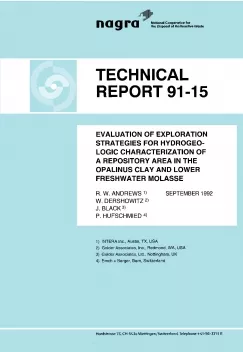
Technical Report NTB 91-15
Evaluation of exploration strategies for hydrogeologic characterization of a repository area in the Opalinus clay and lower freshwater Molasse
The ease of characterization of a site or host rock is directly related to the degree of confidence we place on our ability to find and characterize the key geosphere properties. The easier a site is to characterize, generally the more favorable the site will be (given it is acceptably safe) because we have greater confidence that all potentially unfavorable features will be found.
This report presents a method which has been developed to objectively evaluate the explorability, or ease of characterization, of a particular site or host rock. This method is based on two basic premises. First, it is assumed that the hydrogeologic characteristics of features which may provide a potential conduit (or pathway) for any released radionuclides to travel from the repository to the biosphere are the key parameters affecting long-term safety assessments. Second, it is assumed that our ability to detect these features can be used as a measure of the ease of exploration of the host rock or geographic area under investigation. The ease of characterization may be used as a distinguishing factor in site and host rock compansons.
In order to illustrate the potential applicability of the developed method, we have applied the approach to the Lower Freshwater Molasse (USM) and Opalinus Clay (OPA). In so doing, we have generated possible representative conceptual models of the key hydrogeologic features for both these host rocks.
In the example application of the methodology to the representative USM and OPA geospheres, we have defined the types of exploration methods most likely to be used to detect the hydrogeologic features anticipated to be encountered. In addition, we have estimated the likelihood of the exploration tools being able to detect the features of interest, given that the features are intersected by the chosen exploration tool.
Based on the assumed conceptual models and feature parameter distributions, we have determined the likelihood of preferential pathways existing between the repository and the biosphere. We have also determined the number of preferential pathways likely to exist in the different exploration volumes.
Although the input distributions used in the explorability study presented in this report are hypothetical, the results generated are not dissimilar from what one would intuitively expect. The probability of pathways existing in the OPA is calculated to be very low, and the probability of detecting these pathways at early stages of the exploration is also low, unless significant vertical offsets occur along the normal faults. The probability of pathways existing in the USM is also determined to be low (although higher than in the OPA), and the probability of detecting these pathways is high. A big difference is that, if a feature is detected from underground in the OPA, it should be relatively easy to determine if it is a preferential pathway, while if a feature is intersected in the USM underground exploration phase, it may be quite difficult to determine if it is a preferential pathway because it will be difficult to determine the length of the feature.
In the analysis of exploration programs described in this report, we have made several assumptions. The most crucial assumptions include:
- The definition of which features are potentially critical in safety assessments.
- Simplifying the geometric shape of the potentially critical features.
- The geometric and hydraulic property distributions of the potentially critical features.
- The spatial variability of the hydraulic properties within the potentially critical features.
- The likelihood of detecting and characterizing features given they have been intersected.
All these assumptions should be readdressed at the end of each phase of the exploration program. Additional analyses could be performed using the methodology presented in this report to evaluate the importance of some of the above assumptions (i.e., we could vary the parameter distributions and see what effect they have on the predicted outcome).
In our effort to evaluate the ease of characterization of the OPA and USM, we have developed a quantitative method for determining the explorability of a particular host rock with emphasis on the ability to detect and characterize critical features from a long-term geosphere performance perspective. The applicability of this method has been demonstrated by application to representative OPA and USM geospheres. This has proven to be very useful in affirming our intuitions about the relative performance of the OPA and USM geospheres, as well as the ease of characterization of these two geospheres to confirm the expected performance.
